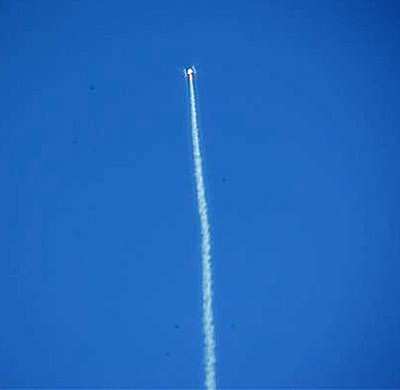Sat, Oct 02, 2004
Burt provides some preliminary information about the rolling
motions seen on the First X-Prize Flight
Burt Rutan: The
complex reason on why the rolling departure occurred will be
described in a report we will post at a later date. What I am
intending to do here is merely address some of the incorrect rumors
about the rolls that have been seen in various news stories and web
discussion groups.
While the first roll occurred at a high true speed, about 2.7
Mach, the aerodynamic loads were quite low (120 KEAS) and were
decreasing rapidly, so the ship never saw any significant
structural stresses. The reason that there were so many rolls was
because shortly after they started, Mike was approaching the
extremities of the atmosphere. Nearly all of the 29 rolls that
followed the initial departure were basically at near-zero-q, thus
they were a continuous rolling motion without aerodynamic damping,
rather than the airplane-like aerodynamic rolls seen by an
aerobatic airplane. In other words, they were more like space
flight than they were like airplane flight. Thus, Mike could not
damp the motions with his aerodynamic flight controls.
Mike elected to wait until he feathered the boom-tail in space,
before using the reaction control system thrusters (RCS) to damp
the roll rate. When he finally started to damp the rates he did so
successfully and promptly. The RCS damping, to a stable attitude
without significant angular rates was complete well before the ship
reached apogee (337,600 feet, or 103 Km). That gave Mike time to
relax, note his peak altitude, and then pick up a digital
high-resolution camera and take some great photos out the windows.
Those photos are now being considered for publication by a major
magazine.
While we did not plan the rolls, we did get valuable engineering
data on how well our RCS system works in space to damp high angular
rates. We also got a further evaluation of our “Care-free
Reentry” capability, under a challenging test condition. As
seen on the videos of the flight, the ship righted itself quickly
and accurately without pilot input as it fell straight into the
atmosphere. No other winged, horizontal-landing spaceship (X-15,
Buran, SpaceShuttle) has this capability.

More News
Aero Linx: Aviators Code Initiative (ACI) Innovative tools advancing aviation safety and offering a vision of excellence for aviators. The ACI materials are for use by aviation pra>[...]
Make Sure You NEVER Miss A New Story From Aero-News Network Do you ever feel like you never see posts from a certain person or page on Facebook or Instagram? Here’s how you c>[...]
From 2016 (YouTube Edition): Who You Gonna Call When You Have a Rocket Engine that Needs a Spacecraft? While at EAA AirVenture 2016, ANN CEO and Editor-In-Chief, Jim Campbell, sat >[...]
"In my opinion, if this isn't an excessive fine, I don't know what is... The odds are good that we're gonna be seeking review in the United States Supreme Court. So we gotta muster>[...]
Expedite Used by ATC when prompt compliance is required to avoid the development of an imminent situation. Expedite climb/descent normally indicates to a pilot that the approximate>[...]
 ANN's Daily Aero-Linx (04.30.25)
ANN's Daily Aero-Linx (04.30.25) ANN FAQ: Turn On Post Notifications
ANN FAQ: Turn On Post Notifications Classic Aero-TV: Agile Aeros Jeff Greason--Disruptive Aerospace Innovations
Classic Aero-TV: Agile Aeros Jeff Greason--Disruptive Aerospace Innovations Aero-News: Quote of the Day (04.30.25)
Aero-News: Quote of the Day (04.30.25) ANN's Daily Aero-Term (04.30.25): Expedite
ANN's Daily Aero-Term (04.30.25): Expedite



